No matter how experienced you are, the craft of software development cannot be practiced without making mistakes. But what separates the average from the great programmers is that they know how to undo their mistakes!
If you’re using Git as your version control system, you already have a host of “undo tools” at hand. This post will show you five powerful ways to undo mistakes with Git!
Discarding Some of Your Local Changes
Coding is often a messy process. At times, it feels like you’re taking two steps forward and one step back. In other words: some of the code that you’ve produced is great … but some of it not so much. Here’s where Git can help you: it allows you to keep what’s good and discard the changes that you don’t want anymore.
Let’s take a look at an example scenario with some “local” changes (aka changes we haven’t committed, yet).
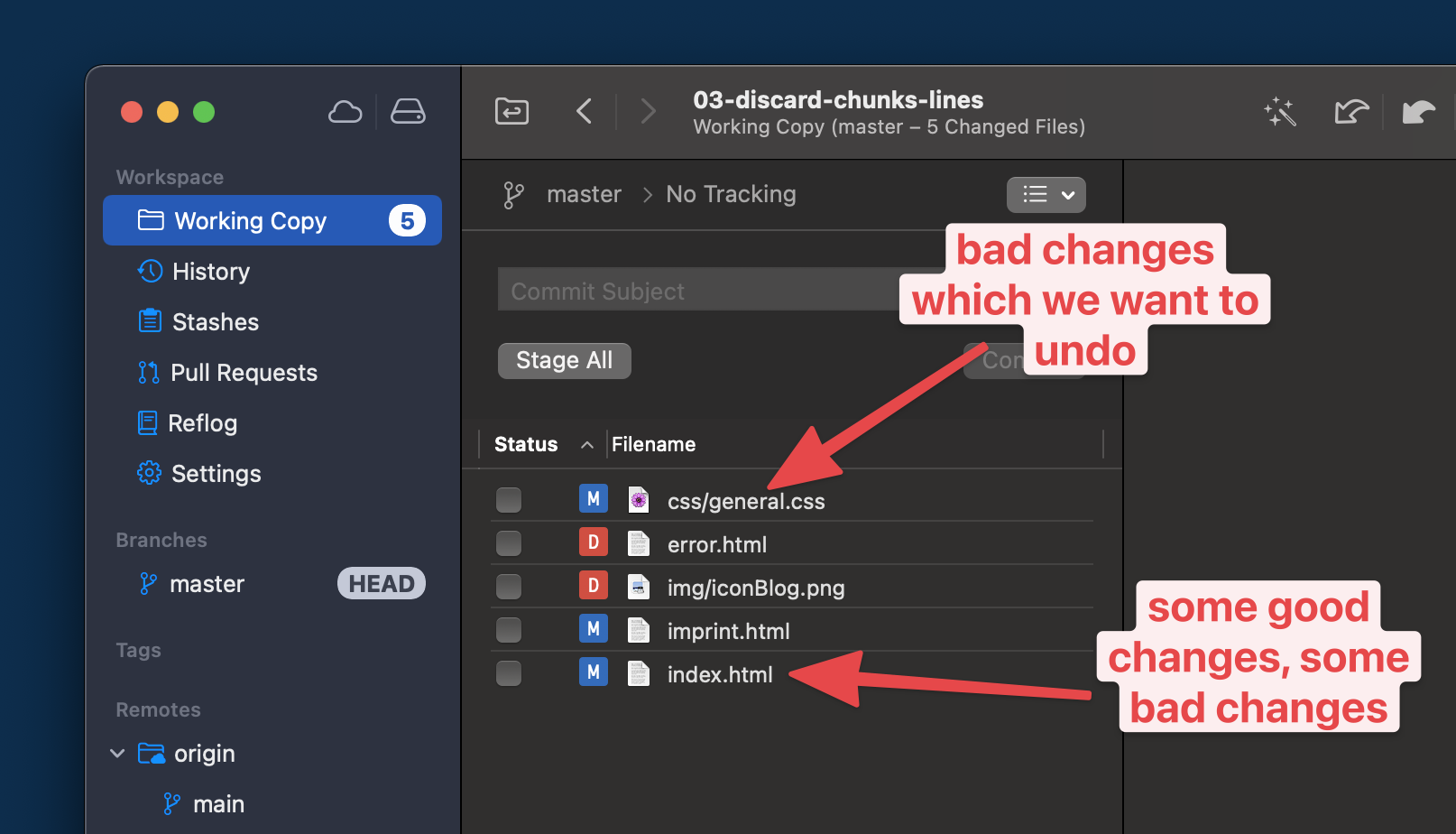
Note: for a better overview and clearer visualization, I’m using the Tower Git desktop client in some of my screenshots. You don’t need Tower to follow along with this tutorial.
Let’s tackle the problem in general.css first. The changes we made went in a totally wrong direction. Let’s undo all of them and recreate the last committed state of that file:
$ git restore css/general.css
Note that, alternatively, I could have used the git checkout command to achieve the same outcome. But because git checkout has so many different jobs and meanings, I strongly prefer the slightly newer git restore command (which is focused solely on these types of tasks).
Our second problem in index.html is a little bit more tricky. Some of the changes we made in this file are actually great, while only some of them need to be undone.
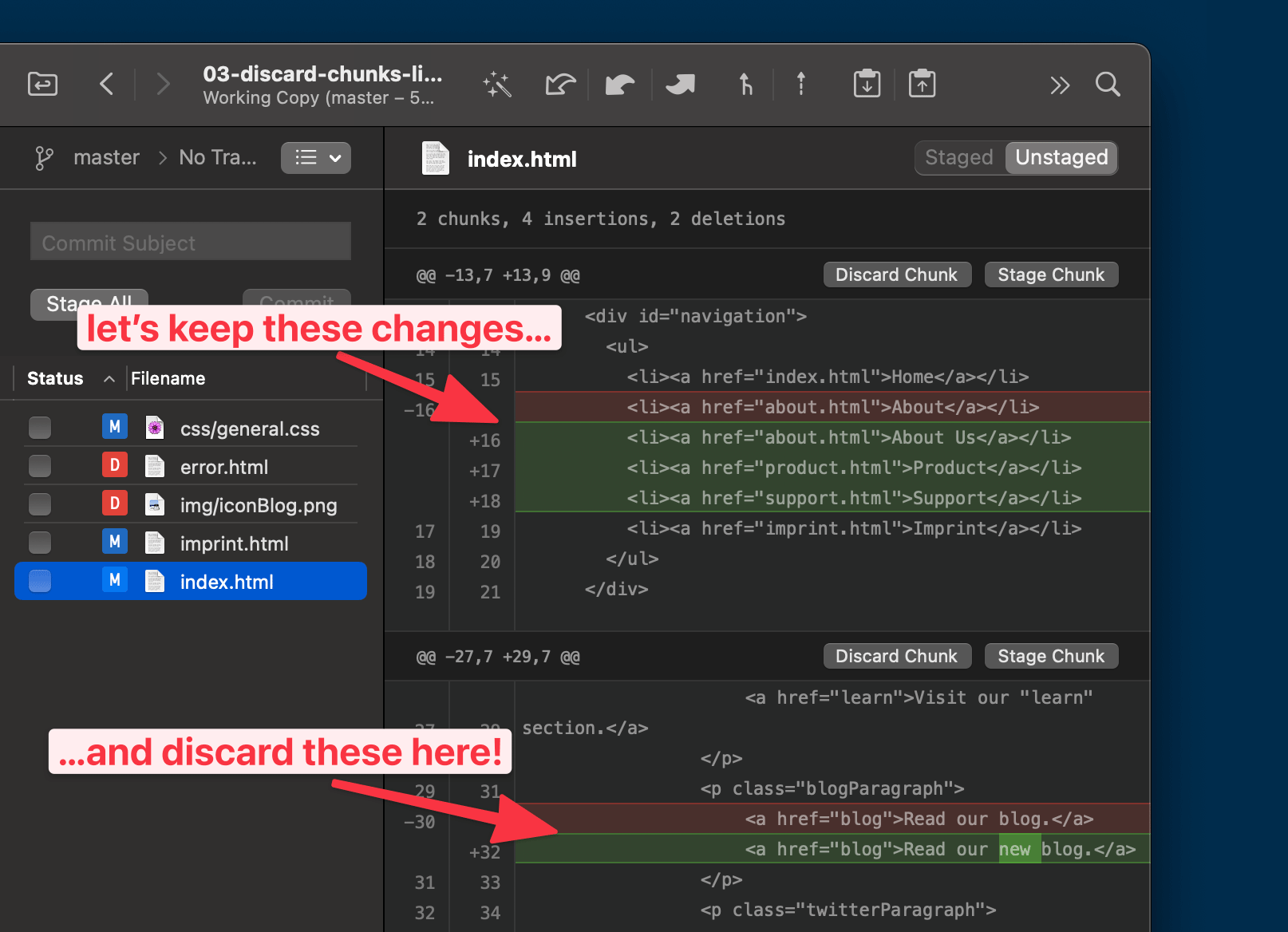
Again, git restore comes to the rescue — but this time with the -p flag, because we want to go down to the “patch” level:
$ git restore -p index.html
Git will then take you by the hand and ask you — for every chunk of changes in that file — if you want to discard it or not.
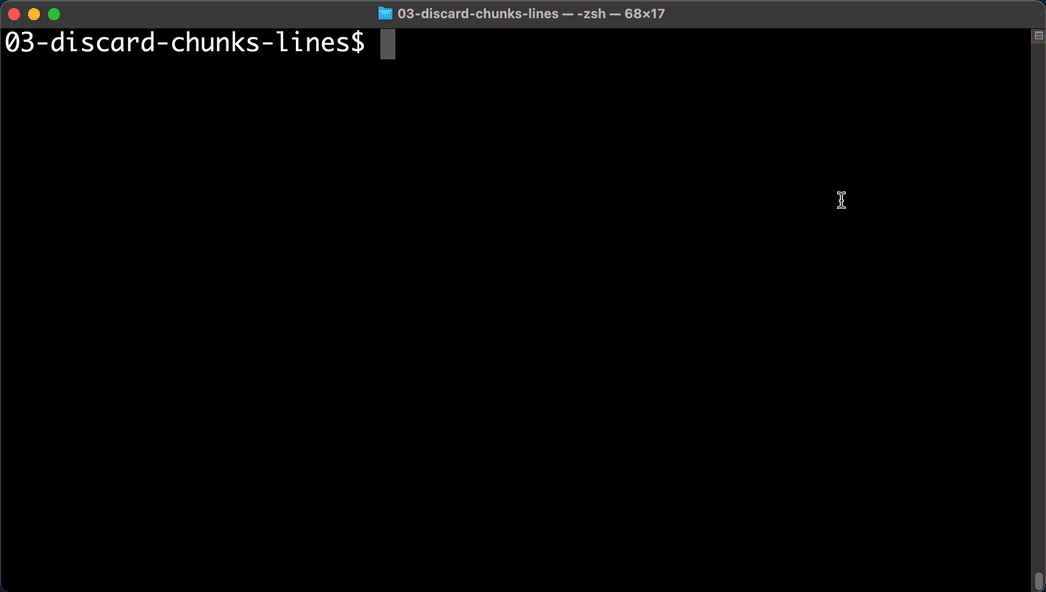
You’ll notice that I typed “n” for the first chunk (in order to keep it) and “y” for the second chunk (in order to discard it). After the process is finished, you can see that only the first, valuable chunk of changes survived — just like we wanted!
Resetting a Specific File to a Previous State
Sometimes you’ll want to restore a specific file to specific revision. For example, you know that index.html was working fine at some earlier point in time, but now it’s not. That’s when you want to turn back time, but only for this specific file and not for the whole project!
The first thing we have to find out is which exact revision we want to restore. With the right set of parameters, you can get the git log command to show you the history of just our single file:
$ git log -- index.html
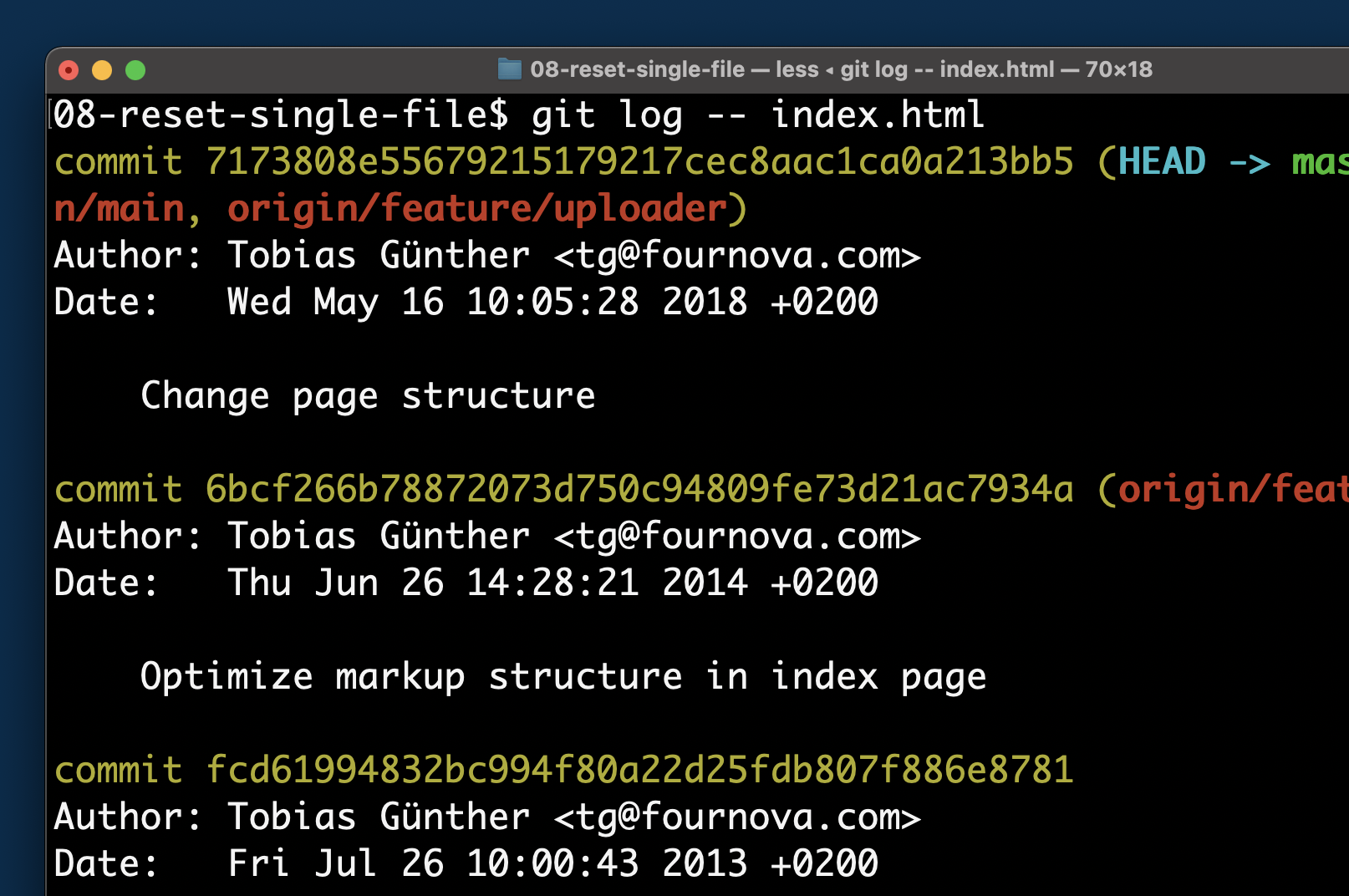
This shows us only the commits where index.html has been changed, which is pretty helpful to find the “bad apple” revision that broke things.
If you need more information and want to look at the contents of those commits, you could have Git show you the actual changes in these commits with the -p flag:
$ git log -p -- index.html
Once we’ve found the bad commit where we broke our lovely little file, we can go on and fix the mistake. We’ll do that by restoring the file at the revision before the bad one! This is important: we don’t want to restore the file at the commit which introduced the error, but at the last good state — one commit before that!
$ git checkout <bad-commit-hash>~1 -- index.html
Appending ~1 to the bad commit’s hash will instruct Git to do exactly that: go one revision before the referenced one.
After executing that command, you’ll find index.html to be modified in your local working copy: Git restored that last good revision of the file for us!
Recovering a Lost Revision with the Reflog
Another great undo tool in Git’s first aid kit is the “Reflog”. You can think of it as a journal where Git protocols all of the HEAD pointer movements that happen in your local repository — things like commits, checkouts, merges and rebases, cherry-picks, and resets. All of the more interesting actions are nicely logged in here!
Such a journal, of course, is perfect for those occasions when things go south. So let’s start by causing a little catastrophe — which we can then repair with the Reflog.
Let’s say you were convinced that your last few commits were no good: you wanted to get rid of them and therefore used git reset to go back to a previous revision. As a result, the “bad” commits disappeared from your commit history — just as you wanted.
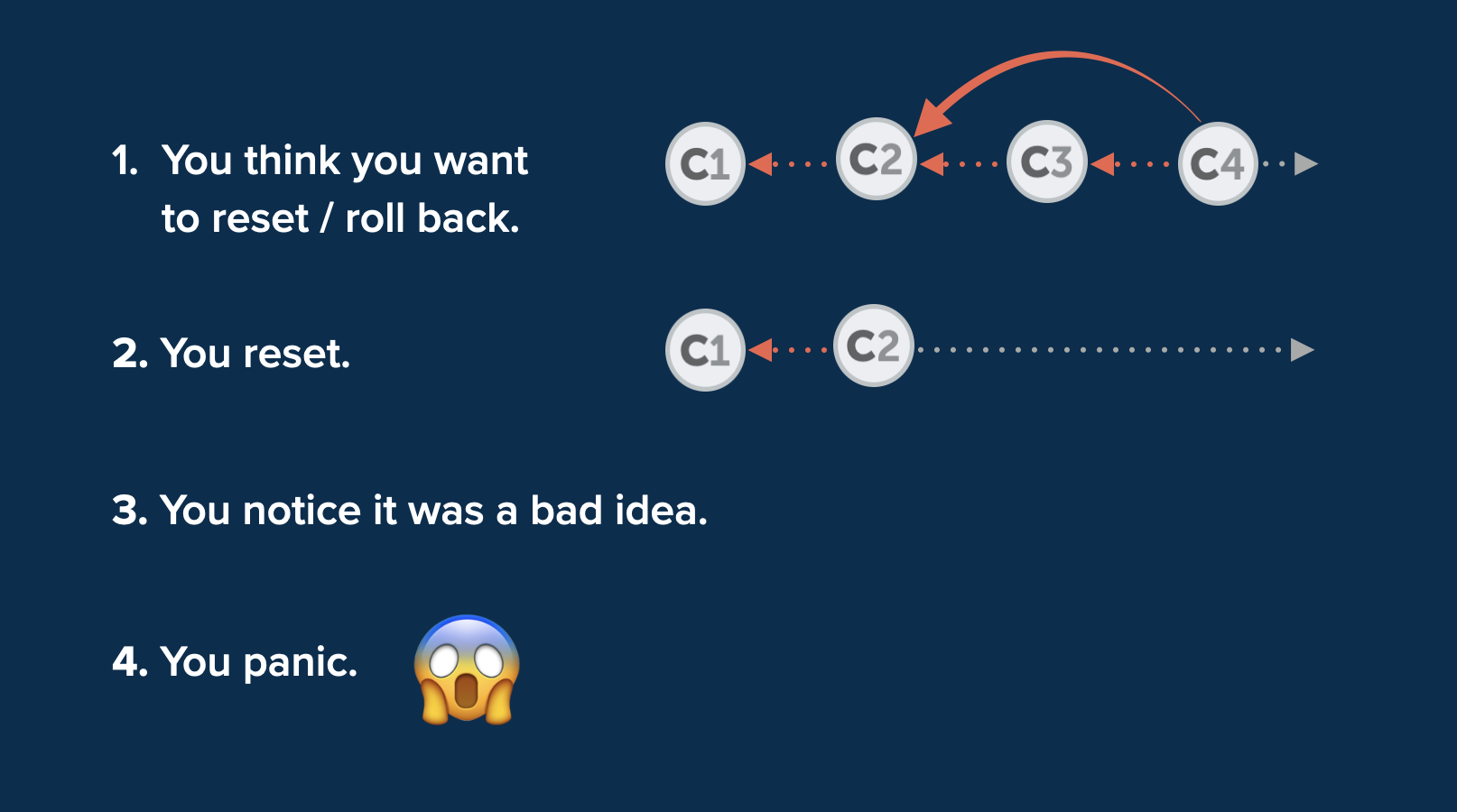
But as life sometimes goes, you notice that this was a bad idea: in the end, the commits weren’t so bad after all! But the bad news, of course, is that you’ve just wiped them from your repository’s commit history! 😱

This is a classic case for Git’s Reflog tool! Let’s see how it can save your neck:
$ git reflog
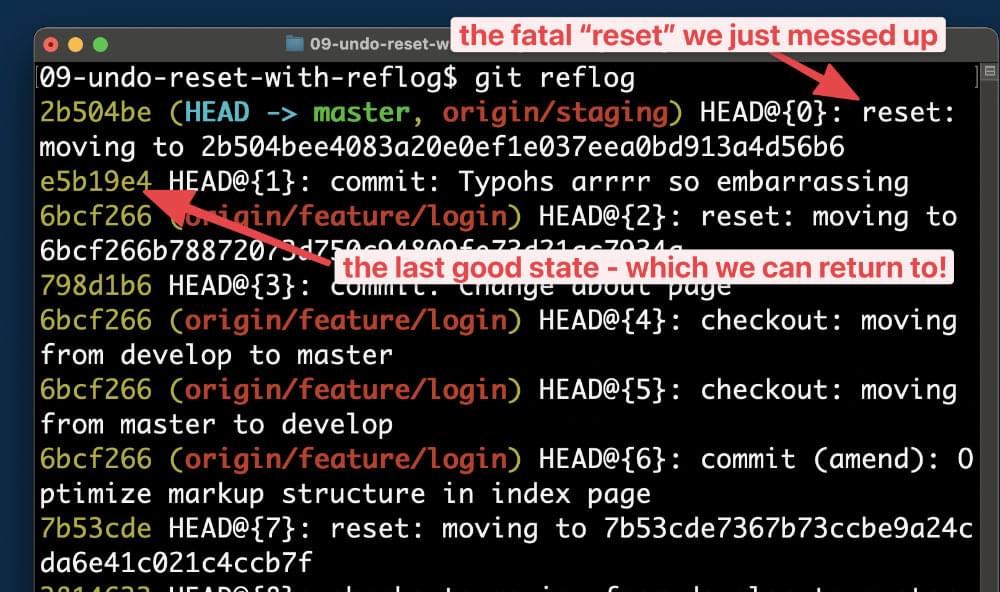
Let’s decompose this bit by bit:
- First of all, the Reflog is very easy to open: a simple
git reflogis all you need. - Second, you’ll notice that the logged states are sorted in chronological order, with the newest one at the top.
- If you look closely, you’ll see that the topmost (that is, newest) item is a “reset” action. Which is what we just did 20 seconds ago. Apparently, the journal works 😉
- If we now want to undo our involuntary “reset”, we can simply return to the state before — which is also neatly documented here! We can simply copy the commit hash of that previous state to the clipboard and take it from there.
To restore this previous state, we can either use git reset again or simply create a new branch:
$ git branch happy-ending e5b19e4
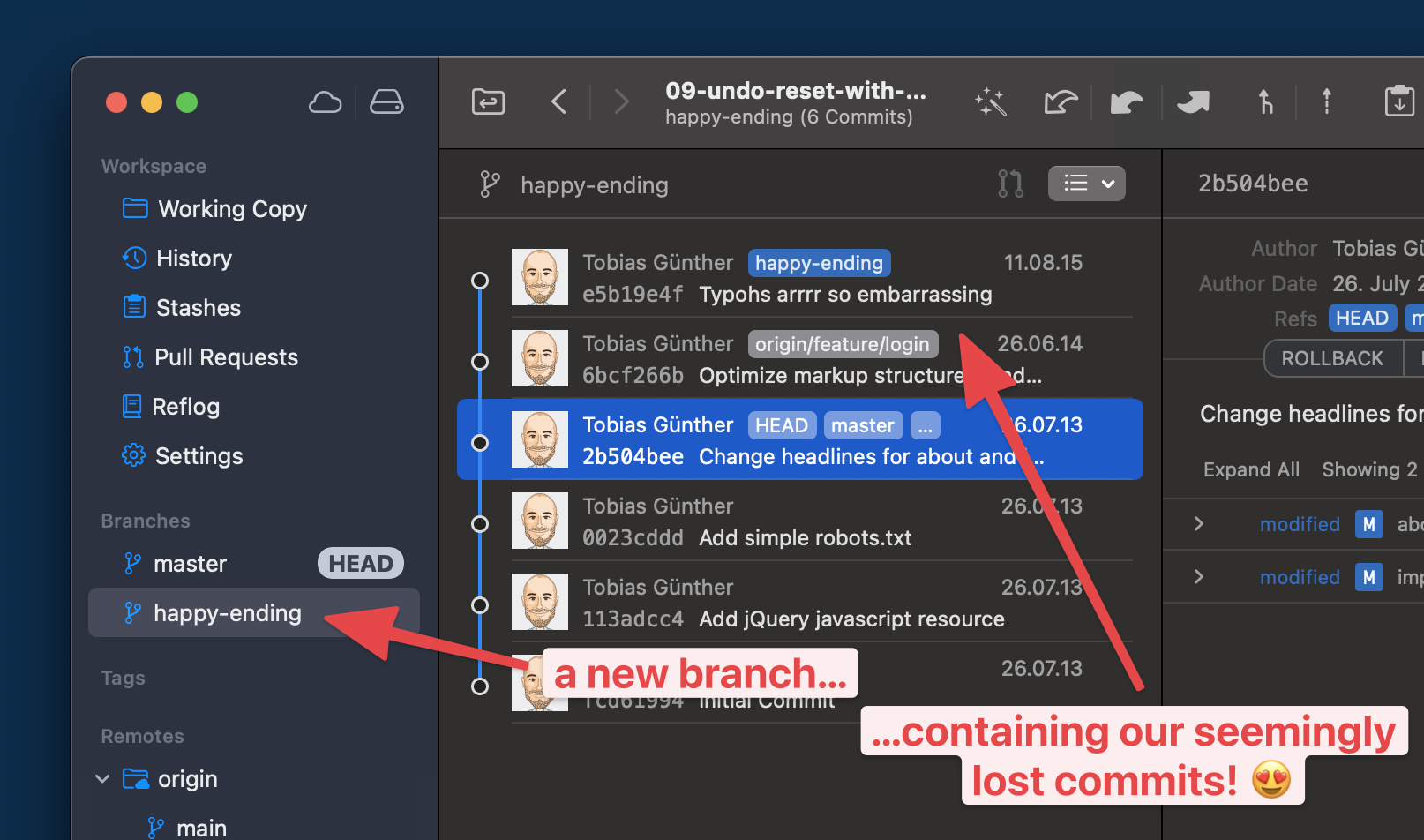
As we can happily verify, our new branch contains the commits we thought we had lost through our accidental git reset hiccup!
Recovering a Deleted Branch
The Reflog can come in handy in other situations as well. For example, when you’ve inadvertently deleted a branch that you really (!) shouldn’t have. Let’s take a look at our example scenario:
$ git branch
* feature/analytics
master
Let’s pretend that our customer / team lead / project manager tells us that the beautiful analytics feature we’ve been working on isn’t wanted anymore. Tidy as we are, we delete the corresponding feature/analytics branch, of course!
Above, you can see that, in our example scenario, we have that branch currently checked out: feature/analytics is our current HEAD branch. To be able to delete it, we have to switch to another branch first:
$ git checkout master
$ git branch -d feature/analytics
error: The branch 'feature/analytics' is not fully merged.
If you are sure you want to delete it, run 'git branch -D feature/analytics'.
Git tells us that we’re about to do something really serious: since feature/analytics contains unique commits that are present nowhere else, deleting it will destroy some (potentially valuable) data. Well … since the feature isn’t needed anymore, we can go on:
$ git branch -D feature/analytics
Deleted branch feature/analytics (was b1c249b).
You probably already anticipated what’s coming now: our customer / team lead / project manager happily tells us that the feature is back in the game! 🥳 They want to pursue it after all! 🎉
Again, we’re faced with an ugly situation where we might have lost valuable data! So let’s see if the Reflog can save our neck one more time:
$ git reflog
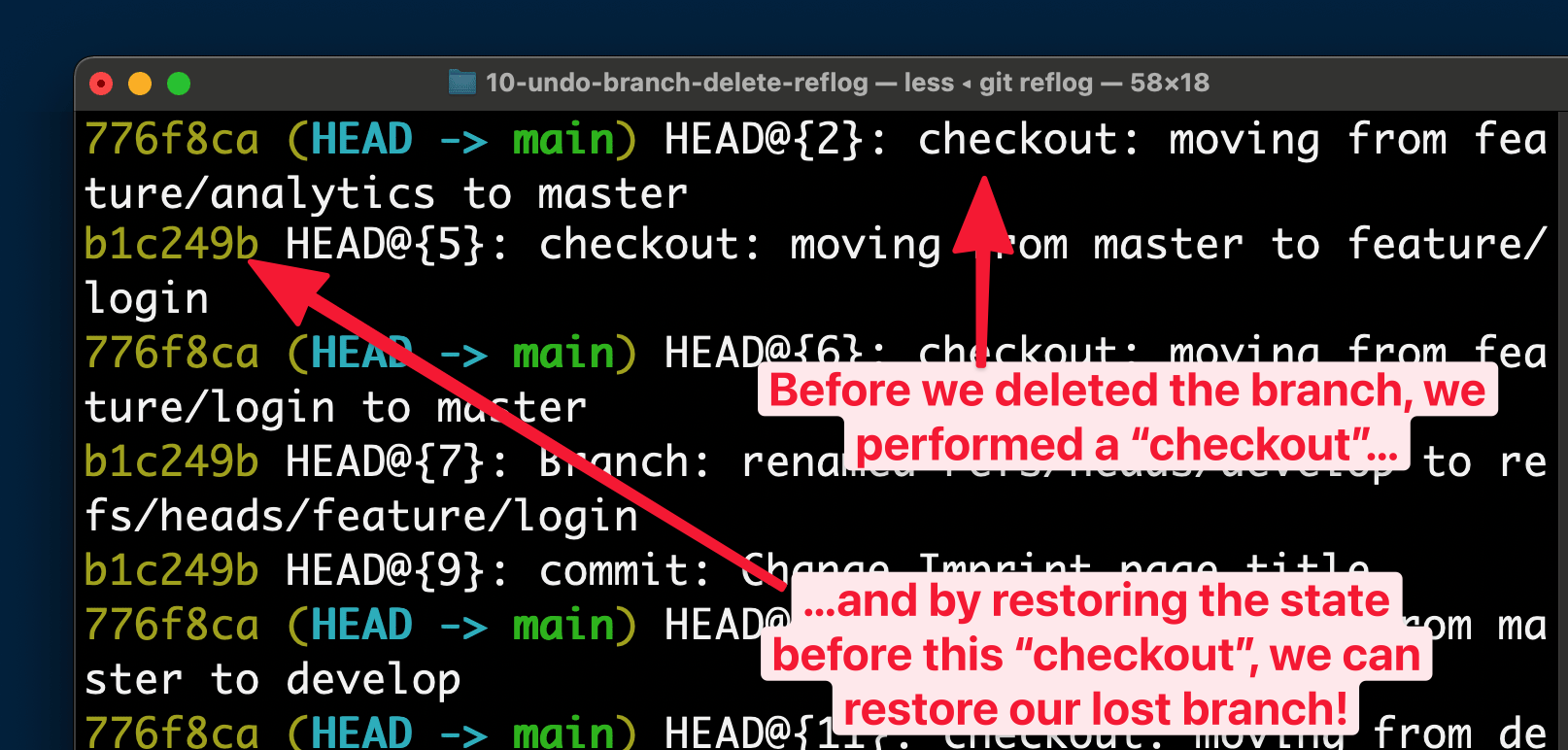
The good news becomes apparent if you take a closer look. Before we were (disastrously) able to delete our branch, we had to perform a git checkout to switch away from it (since Git doesn’t allow you to delete the current branch). Of course, this checkout was also logged in the Reflog. In order to restore our deleted branch, we can now simply take the state before as a starting point for a new branch:
$ git branch feature/analytics b1c249b
And voila: our branch is back from the dead! 🌸💀🌺
If you happen to use a desktop GUI like Tower, undoing mistakes like these is often as simple as pressing CMD + Z.

Moving a Commit to a Different Branch
Let’s close with another true classic from the “Oh no!” department: committing on the wrong branch.
Today, many teams have a rule in place that forbids committing directly to long-running branches like “main”, “master” or “develop”. Typically, new commits should arrive on those branches only through merges/rebases. And yet, we sometimes forget and commit directly …
Let’s take the following scenario as an example.
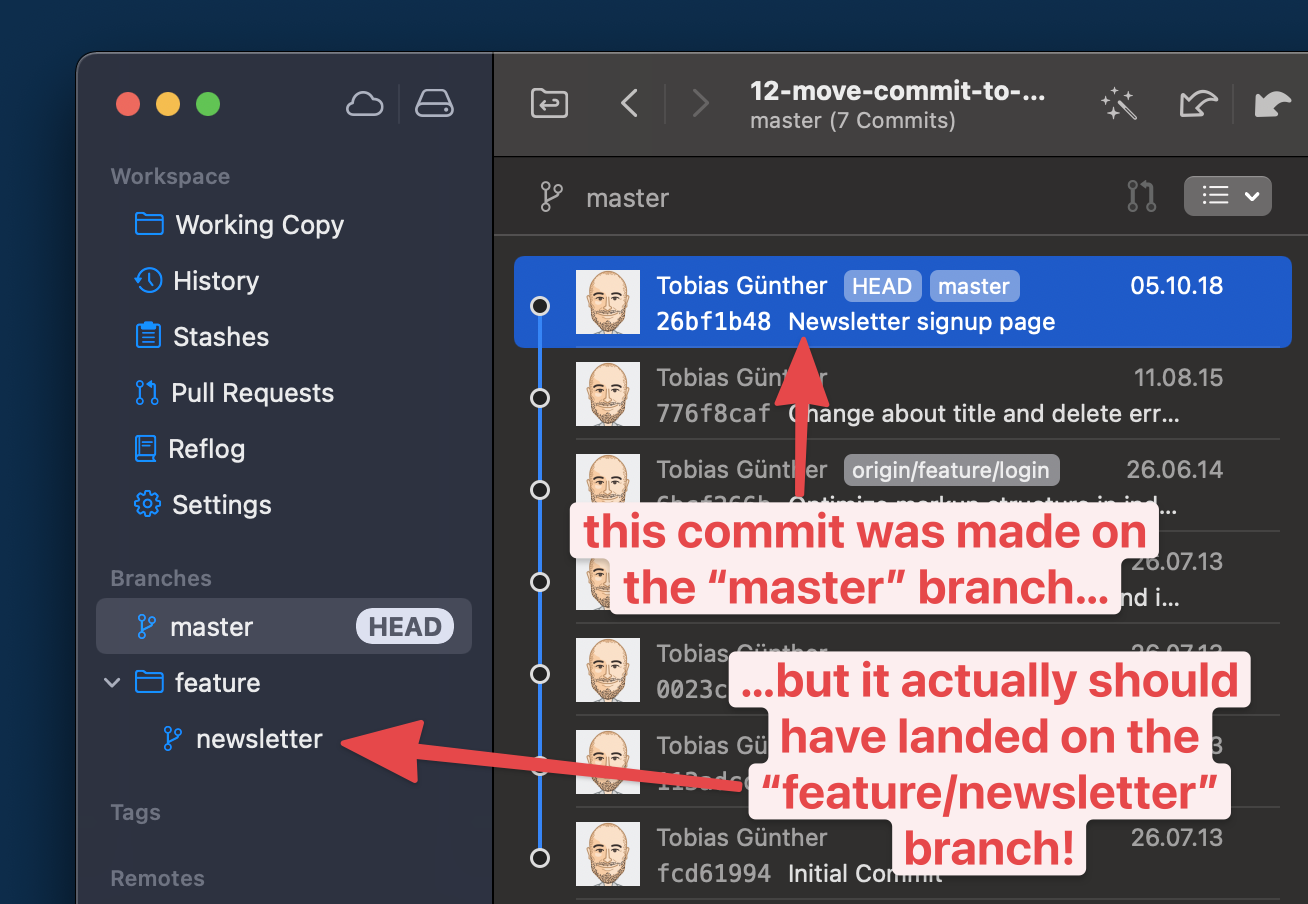
We should have committed on feature/newsletter, but inadvertently pulled the trigger on the master branch. Let’s look at the solution, step by step.
First, we have to make sure we’re on the right branch this time, so we’re checking out feature/newsletter:
$ git checkout feature/newsletter
Now we can safely move that commit over using the cherry-pick command:
$ git cherry-pick 26bf1b48
We can take a look at feature/newsletter and will see that, now, the commit exists here as well.

So far, so good. But cherry-pick did not remove the commit from the master branch — where it should never have been. So we’ll have to clean up our mess there, too:
$ git checkout master
$ git reset --hard HEAD~1
We’re switching back to master and then using git reset to remove the (here) unwanted commit from the history.
Finally, all is well again — so you may start your happy dance now! 💃🕺🏻
Undoing Mistakes is a Superpower
I’ve said it before, and unfortunately we all know it’s true: we cannot avoid mistakes! No matter how great a programmer we are, we’ll mess up from time to time. The question, therefore, is not if we make mistakes, but rather how well we can deal with them and fix the problems?
If you want to learn even more about Git’s undo tools, I highly recommend the “First Aid Kit for Git”. It’s a (free) collection of short videos that show you how to clean up and undo mistakes in Git.
Have fun moving fast, breaking things — and of course, repairing them!
Frequently Asked Questions (FAQs) about Undoing Mistakes with Git
What is the difference between git reset and git revert?
Git reset and git revert are two commands that help you undo changes in your Git repository, but they work in different ways. Git reset moves your HEAD pointer to a specific commit. This means it effectively “forgets” any commits that came after the one you reset to. It’s a destructive operation and should be used with caution. On the other hand, git revert creates a new commit that undoes the changes made in a specific commit. It’s a safe operation because it doesn’t alter the existing history.
How can I undo a git add operation?
If you’ve staged changes with git add and want to undo this, you can use the git reset command. For example, if you want to unstage a specific file, you can use the command git reset
Can I undo a git commit?
Yes, you can undo a git commit using the git reset or git revert commands. Git reset will move your HEAD pointer back to the commit before the one you want to undo, effectively erasing the unwanted commit. Git revert, on the other hand, will create a new commit that undoes the changes made in the unwanted commit.
How can I undo changes in a specific file?
If you’ve made changes to a specific file and want to undo them, you can use the git checkout command. For example, git checkout —
What does git stash do?
Git stash is a command that allows you to temporarily save changes that you don’t want to commit yet. This is useful if you need to switch to a different branch but don’t want to commit your current changes. You can apply the stashed changes later with git stash apply.
How can I view my git history?
You can view your git history using the git log command. This will show you a list of all the commits in your repository, along with their commit messages.
Can I undo a git push?
Yes, you can undo a git push, but it’s a bit more complicated than undoing local changes. You’ll need to use the git push command with the -f or –force option to overwrite the remote repository with your local one. Be careful with this, as it can cause problems for other people who are working on the same repository.
How can I undo multiple commits?
If you want to undo multiple commits, you can use the git reset command with the HEAD~
What is the difference between a soft and hard reset?
A soft reset moves your HEAD pointer to a specific commit, but leaves your working directory and staging area unchanged. This means you’ll still see the changes from the “forgotten” commits as uncommitted changes. A hard reset, on the other hand, discards all changes in the working directory and staging area, effectively taking your repository back to the state it was in at the specified commit.
Can I recover a commit after a hard reset?
Yes, it’s possible to recover a commit after a hard reset, but it’s not straightforward. Git keeps a log of all ref updates (like moving the HEAD pointer) in the reflog. You can use the git reflog command to find the commit you want to recover, and then create a new branch at that commit with git branch.
Tobias Günther is a co-founder of “Tower”, the popular Git desktop client that helps more than 100,000 developers around the world to be more productive with Git.









